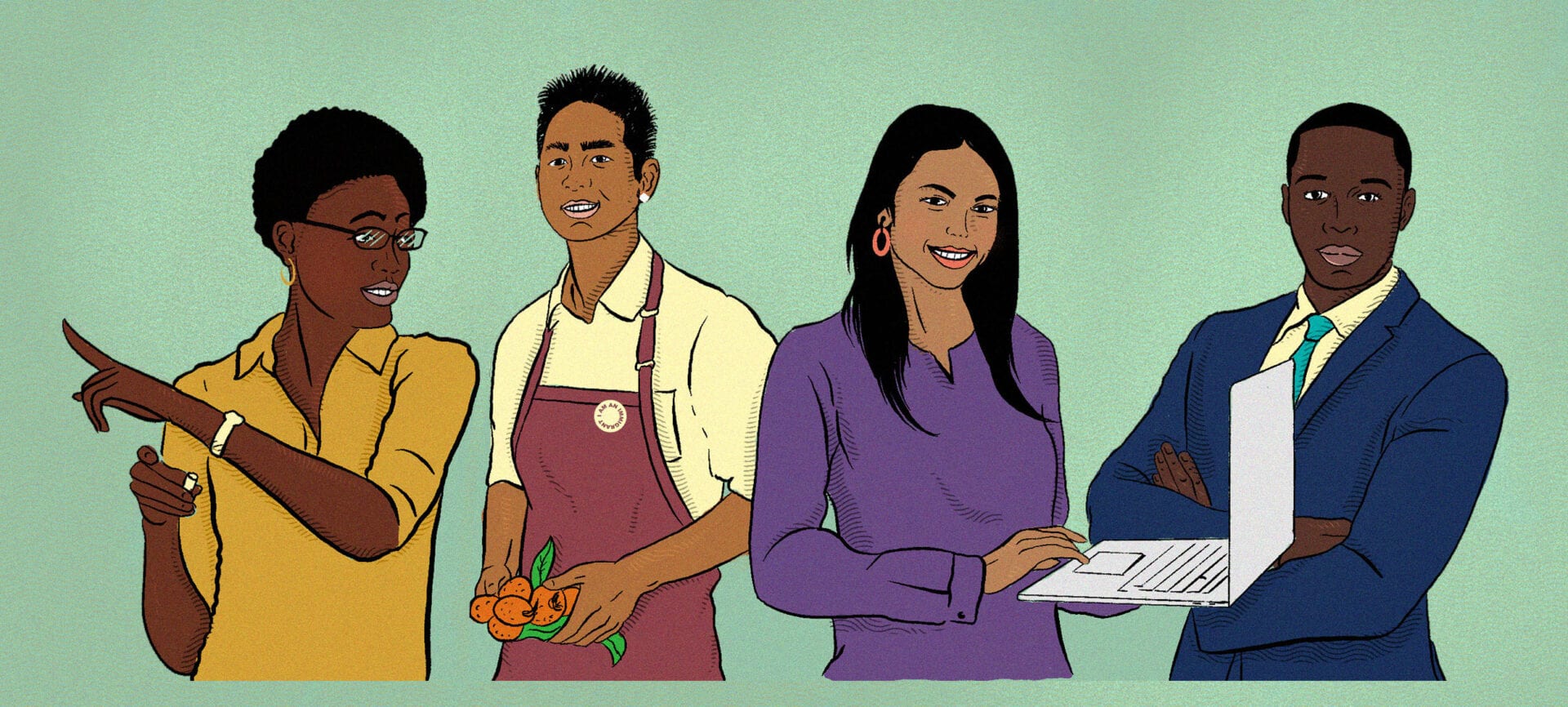
How Trump’s new executive order impacts American companies and immigrants who work or want to work in the United States.
Above: Illustration of immigrants impacted by work visas ban. Brian Herrera/Borderless Magazine
President Donald Trump signed an executive order on June 22 restricting several work visas through the end of 2020. The order restricts everything from tech workers to au pairs. It’s expected to prevent over 200,000 immigrants from entering the United States for work, according to the Migration Policy Institute.
Here are details about the new order.
What does it say?
The new executive order temporarily bans foreign workers from using certain nonimmigrant visas from entering the United States through the end of 2020.
The order went into effect on June 24 and is set to expire on December 31 but may be extended.
Who does the new order impact?
It’s expected to prevent 219,000 immigrants from entering the United States between now and the end of 2020, according to an estimate by the Migration Policy Institute.
These are the work visas included in the ban:
– The H-1B visa for employees with bachelor’s degrees or higher in fields such as architecture, the IT industry, engineering and science. This visa was set to employ 29,000 foreign workers in the U.S. from July to December of 2020, according to the Migration Policy Institute.
– The H-2B visa for employees seeking seasonal nonagricultural jobs. This type of visa provides jobs for people working at grocery stores, gardening jobs, customer service companies, etc. Over 23,000 will be put on hold until the ban is over.
– The J-1 visa for employees seeking work as an intern, teacher, camp counselor, or at any summer work travel program. An estimate of 117,000 foreign workers will suffer the consequences of the ban.
– The L-1 visa for managers or executives who work at companies located outside of the United States who want to be transferred to a branch of their company in the United States. From July to December of 2020, an estimate of 6,000 visas will be put on hold.
Who is excluded from the order?
It excludes medical workers dealing with coronavirus research. It also excludes people working in restaurants, catering companies and any type of food-related work.
Above: Borderless Magazine’s engagement reporter Diane Bou Khalil speaks with attorney Kristen Harris about the H-1B visa executive order.
How will it impact work visas set to expire before the end of the year?
People already in the United States with a nonimmigrant working visa set to expire before the end of 2020 may file for an extension before the visa expires, says immigration attorney Kristen Harris.
Visa holders should have no issue leaving the country and then going to a U.S. consulate or embassy to apply for a new H-1B visa stamp to come back to the United States.
Harris recommends, however, that people able to stay in the United States do so until more information about how the order is being enforced or extended becomes available.
Why did Trump restrict these visas?
Trump argues that he is protecting American workers and curbing the spread of coronavirus by reducing the number of immigrants entering the United States for the rest of the year.
The U.S. unemployment rate is currently at 11.1 percent and an estimated 21 million people have lost their jobs due to the COVID-19 pandemic. Some 4.8 million jobs were added in June, but renewed shutdowns could accelerate the continuing layoffs, according to the New York Times.
Is anyone criticizing the order?
The Internet Association — whose members include Amazon, Google, Facebook, Microsoft, Twitter, Uber and PayPal — condemned Trump’s order.
The “diverse and accomplished” work visa holders in the tech industry help attract the “best and brightest” to create jobs and grow the economy, said Sean Perryman, the association’s director of social impact.
What is unique about this executive order compared to others Trump has signed to slow or stop immigration?
The June 22 order is unique because of how quickly it went into effect.
“I have been practicing immigration law for 14 years now, and we’ve really never seen anything like this before,” Harris said.
It’s not a coincidence this order was signed days after the Supreme Court blocked Trump from ending DACA, she said. The new order is likely an attempt by Trump to appease his supporters and continue his hardline immigration policies.
The June 22 order is the latest in a series of immigration bans Trump has enacted since becoming president. As recently as April, Trump signed an executive order suspending new green cards approvals for 60 days. That order was estimated to block 26,000 immigrants from entering the United States each month, according to the Migration Policy Institute.

